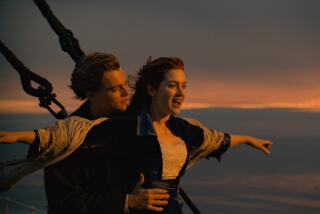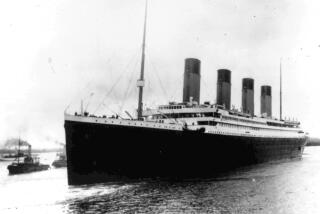The Titanic on a human scale near Belfast
- Share via
BELFAST, Northern Ireland — Everyone knows how the tale of the Titanic ends, but what of its beginning?
The Titanic was born in Belfast, along with its sister Olympic-class ships, the Olympicand the Gigantic (later renamed the Britan¿nic). A new Titanic Belfast museum openedlast month, and there’s also a year-long sched¿ule of events celebrating the Titanic’s 100thanniversary that includes two exhibitions at the Ulster Folk & Transport Museum, on 170acres outside Belfast.
As soon as you enter the “Designing Titanic” section, you’re transported into the world of the Harland & Wolff shipyard: The sounds of crashing pipes, banging hammers and shouting workmen are heard throughout. In the yard, your hat indicated your status; if you wore a “duncher,” or flat cap, you were a regular workingman and would be overseen by a foreman, who wore a bowler. A touch-screen allows you to search through Olympic-class blueprints, which were modified for the Titanic. They show the deck plan, the bulkheads and specifications for riveting.
“Building Titanic” is home to the kids’ favorite, “A Riveting Challenge,” which is a kind of Whac-a-Mole game that challenges you to hit “rivets” as they light up. The most difficult level shows how quickly the best riveters on the Titanic could work, with lights flashing so rapidly that it was almost like being in a disco.
Nearby, the “Tools of the Trade” section shows the intimate connection that one of the shipwrights who worked on the Titanic lifeboats had with his work. The company didn’t supply tools, so men would build their own sets over the years, often passing them on to their sons when they retired. This set was well worn but still looked ready to use.
On the touch-screen in “Titanic Stories,” you can click on a foreman’s whistle, a drinks tray, a fancy lady’s hat or a hammer and watch as actors re-create accounts of life onboard or listen to descendants of those who worked on the Titanic tell their family stories.
The “Sister Ships” display contains the Olympic’s ornately decorated wooden fittings and furnishings, and the advertising that sold the Olympic class to the world. Here you also can see some recovered Titanic crockery, glassware, a hand mirror, perfume vials and other artifacts, and at the center is a scale model of the sinking Titanic.
You can hear crackly sounding recorded interviews with several original crew members and other survivors, and around the edges of the display are tiny representative models of everyone on board and who lived or died. The crew and third-class casualties-to-survivors ratio is particularly sobering. Overall, it’s that human scale you remember the most about the Titanic.
I left the Transport Museum and drove a couple of minutes to the Folk Museum, home to “TITANICa: The People’s Story” and Ballycultra, a fictional Irish town of the early 1900s re-created with buildings moved here from Northern Ireland.
I walked down the cobbled streets of Cluan Place, a row of quaint working-class houses that were built in 1884 near the shipyard, and I stepped into the house of “Bob Carlisle,” a riveter on the Titanic.
Inside his smart, well-kept house, a real coal fire burned brightly as he read from a book of poetry. He dismissed talk of faulty rivets on the Titanic — the Olympic was built almost exactly the same and had a long career — and then explained that as one of the riveters, he earned more money than other workers. This meant that his house had bigger windows, a higher ceiling, gas lighting, a cast-iron kitchen range and even an outside flush toilet.
He still worked hard, though; the hours were long and the work was tough, loud and noisy. Like all his co-workers, he was quickly going deaf, so I asked why he didn’t protect his ears: “This is man’s work. No one would dare do that,” he said.
“Bob” was John Savage, a visitor guide who has played many roles in Ballycultra, including a laborer and the bank manager.
As I wandered through town I came upon other reminders of the Titanic: At Baird’s Print Shop, you can get a facsimile of the ticket to Titanic’s launch. And the Picture House movie theater shows a flickering silent newsreel film of the actual event.
As I made my way back toward reality, I waved to “Bob” as he made his way down Tea Lane, as if he were passing into the mists of time.
More to Read
Sign up for Essential California
The most important California stories and recommendations in your inbox every morning.
You may occasionally receive promotional content from the Los Angeles Times.













